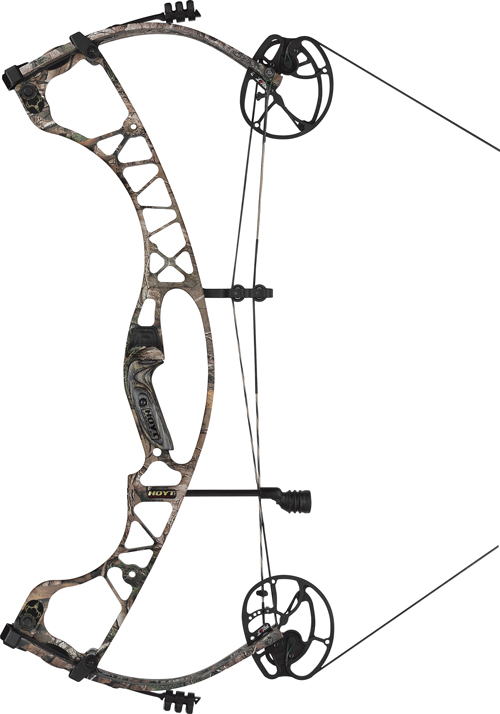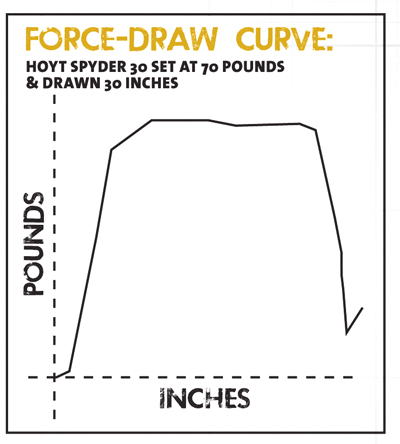Hoyt’s Spyder series, including the Spyder 30, Spyder 34, and Spyder Turbo appear to be natural successors to Hoyt’s Vector series of bows. (The Vector 32 remains in the 2013 line-up, while the other two bows in the series have been discontinued.) The distinctive if not quite unique bridged riser helps identify the Spyder bows as Hoyts, but the Spyders achieve some savings in weight by shaving metal off the aluminum riser to give these bows a lighter appearance, not to mention feel. The weight is particularly noticeable in the Spyder 30 which, at 3.8 pounds, is equal to that of Hoyt’s carbon riser bows. At 30 inches axle-to-axle, it’s also Hoyt’s most compact bow to date.
The Spyder bows sport Hoyt’s famous RKT cam & 1/2 system, though slightly modified. A proven synchronized cam system, the clearest difference between these cams and those found on the carbon riser bows is that the Spyder’s RKT cams are larger, resulting in a slightly smoother draw cycle that generates the same speeds as the originals. To maximize performance, the cams are sized to fit different draw lengths. In the case of the Spyder 30, modules are specific for 24.5 to 26 inches, 26 to 28 inches, and 28 to 30 inches.
 Brand new on the Spyder bows (as well as on Hoy’s 2013 carbon riser bows) is the somewhat controversial AirShox limb damping system. Replacing Hoyt’s AlphaShox, which were sandwiched between the limbs, the AirShox extend back from the limb pockets on a machined aluminum tongue, contacting the outside of the limbs only. As the bow is drawn and the limbs compress, they actually draw away from the AirShox. At the shot, the limbs recoil against the AirShox as they return to their starting position. They can be easily removed with a hex wrench, should any shooter find them objectionable.
Brand new on the Spyder bows (as well as on Hoy’s 2013 carbon riser bows) is the somewhat controversial AirShox limb damping system. Replacing Hoyt’s AlphaShox, which were sandwiched between the limbs, the AirShox extend back from the limb pockets on a machined aluminum tongue, contacting the outside of the limbs only. As the bow is drawn and the limbs compress, they actually draw away from the AirShox. At the shot, the limbs recoil against the AirShox as they return to their starting position. They can be easily removed with a hex wrench, should any shooter find them objectionable.
Further distinguishing the Spyder bows from the Vector series is the wood grip, as opposed to a molded rubber grip. The laminated wood adds some glamour to the Spyder’s appearance; whether or not it is preferable to the softer, warmer molded rubber is largely a matter of personal preference. With regard to appearance, Hoyt is known for bows with excellent fit and finish, and the Spyders are no exception. Noticeably missing from Hoyt’s 2013 offerings are the bright red cam modules, roller guides, and other trim features. Hoyt does offer custom color grips, AirShox, and Stealth Shot string suppressors for shooters who like the custom look.
Among several tried-and-true Hoyt features making an encore on the Spyder bows are Hoyt’s offset stabilizer mount, the Stealth Shot string suppressor, the Silent Shelf, and the Inline Roller Guard.
Shooting The Bow
I tuned the bow by setting the arrow perpendicular to the string and aligning it with the Berger hole. For centershot I eyeballed the arrow to line it up with the string and the center of the grip. Arrow flight seemed excellent, but I paper tuned anyway and with a few quick adjustments was shooting bullet holes with an unfletched arrow. The string suppressor was slightly off center and was contacting the string with a little pressure. I loosened it with a hex wrench, twisted it to center on the string and adjusted depth so it was barely touching the string—the whole operation took about 30 seconds.
Hunters who have owned Hoyt bows in the recent past will find the feel of this bow familiar, though probably a little lighter in weight and possibly a little smoother drawing. The light weight is complemented by great balance, which is further complemented by Hoyt’s offset stabilizer. Hunters with bow-mounted quivers will particularly appreciate that feature, but even bowsights alone can throw a bow noticeably off balance. While the Spyder 30’s Rocket Cams are aggressive enough to achieve more than enough speed, there is not a detectable hump or bump in this bow’s draw cycle. The back wall is adequately firm, and this bow is very steady at full draw; the cams aren’t grabby, and let-down is very easy.
The unique and radical AirShox work; this is a super-quiet bow. Recoil is minimal, and the barely detectable vibration stops rapidly after the shot. I’m a big fan of Hoyt’s Silent Shelf system, which does more than just prevent arrow clatter. I find that fall-away rests can be surprisingly noisy, and the Silent Shelf dampens the sound of fall-away rests better than moleskin or similar remedies.
I try to nitpick every bow, but had trouble finding any nits to pick on the Spyder 30 beyond the previously mentioned off-center string suppressor, which arguably did not rise even to the level of a nitpick. OK, here’s one: I liked the red trim on last year’s Hoyt bows.
Essentially, the Spyder 30 is a bow that does everything hunters want a bow to do, and does it with flying colors. It is not radical in design, appearance, or performance, but does embody the current state of the art in bow design; it’s very fast, very forgiving, very quiet, and a pleasure to shoot. It’s the kind of bow that lets the hunter in a high-adrenaline situation forget about everything except the target.
HOYT SPYDER 30 SPECS
Letoff:.................................................... N/A
Brace height:...................................... 63⁄4 inches
Weight: ................................................. 3.8 pounds
Axle-To-Axle Length:.................... 30 inches
Speed: ................................................... 330 fps
Draw lengths:..................................... 241⁄2 to 30 inches
Draw weights:.................................... 40, 50, 60, 65, 70, 80 pounds
Options: ............................................... Realtree Xtra, Realtree Max-1, Blackout, Realtree Snow, Realtree Pink, Bone Collector, Vicxen, Half and Half, eight target finishes.
Suggested Retail: .......................... $1,000
OBJECTIVE TESTS (30 Inches Draw)
Peak Hold (Pounds)*:................... 70
Weight, Full Draw (Pounds)*:... 14
Arrow Weight: .................................. 385 grains........ 500 grains
Arrow @ 70 Pounds*: .................. 312 fps.............. 276 fps
Arrow @ 60 Pounds*:.................. 292 fps.............. 258 fps
K.E. @ 70 Pounds*:......................... 83.24 ft. lbs..... 84.59 ft. lbs.
K.E. @ 60 Pounds*:......................... 72.91 ft. lbs..... 73.92 ft. lbs.
Sound Level (dBA) @ 60 Pounds:......................... 58 49
* Rounded to nearest half-pound.







